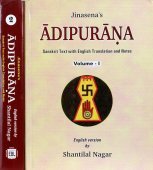Shatapatha, Śatapatha: 5 definitions
Introduction:
Shatapatha means something in Hinduism, Sanskrit. If you want to know the exact meaning, history, etymology or English translation of this term then check out the descriptions on this page. Add your comment or reference to a book if you want to contribute to this summary article.
The Sanskrit term Śatapatha can be transliterated into English as Satapatha or Shatapatha, using the IAST transliteration scheme (?).
In Hinduism
Purana and Itihasa (epic history)
Source: Cologne Digital Sanskrit Dictionaries: The Purana IndexŚatapatha (शतपथ).—A Janapada.*
- * Vāyu-purāṇa 45. 110.

The Purana (पुराण, purāṇas) refers to Sanskrit literature preserving ancient India’s vast cultural history, including historical legends, religious ceremonies, various arts and sciences. The eighteen mahapuranas total over 400,000 shlokas (metrical couplets) and date to at least several centuries BCE.
Languages of India and abroad
Sanskrit dictionary
Source: Cologne Digital Sanskrit Dictionaries: Cappeller Sanskrit-English DictionaryŚatapatha (शतपथ).—[adjective] having a hundred paths, many-sided; [masculine] & brāhmaṇa [neuter] T. of a Brāhmaṇa.
Source: Cologne Digital Sanskrit Dictionaries: Monier-Williams Sanskrit-English Dictionary1) Śatapatha (शतपथ):—[=śata-patha] [from śata] mfn. having a h° (id est. numerous) paths, very many-sided, [Mahābhārata; Catalogue(s)]
2) [v.s. ...] proceeding in a h° ways, [Siṃhāsana-dvātriṃśikā or vikramāditya-caritra, jaina recension]
3) [v.s. ...] m. = next
4) Śātapatha (शातपथ):—[=śāta-patha] [from śāta] mf(ī)n. relating or belonging to or based upon the Śatapatha-brāhmaṇa, [Kāśikā-vṛtti; Śaṃkarācārya]
5) [v.s. ...] = śatapatha-br, [Hemādri’s Caturvarga-cintāmaṇi]
[Sanskrit to German]
Sanskrit, also spelled संस्कृतम् (saṃskṛtam), is an ancient language of India commonly seen as the grandmother of the Indo-European language family (even English!). Closely allied with Prakrit and Pali, Sanskrit is more exhaustive in both grammar and terms and has the most extensive collection of literature in the world, greatly surpassing its sister-languages Greek and Latin.
Kannada-English dictionary
Source: Alar: Kannada-English corpusŚatapatha (ಶತಪಥ):—[noun] the well known brāhmaṇa (Saṃskṛta text, containing one hundred chapters) attached to Vājasanēyi samhita (Śukla yajurvēda).
--- OR ---
Śatapatha (ಶತಪಥ):—
1) [noun] a walking a short distance to and fro several times.
2) [noun] ಶತಪಥ ಹಾಕು [shatapatha haku] śatapatha hāku to walk a short distance to and fro reteadedly several times.
Kannada is a Dravidian language (as opposed to the Indo-European language family) mainly spoken in the southwestern region of India.
See also (Relevant definitions)
Partial matches: Patha, Shata, Pata, Patta.
Starts with: Shatapathabrahmana, Shatapathabrahmananuvakasamkhya, Shatapathambogu, Shatapathambrahmana, Shatapathashruti, Shatapathavrahmana.
Query error!
Full-text (+6236): Shatapathabrahmana, Shatapathashruti, Shatapathika, Kanvashatapathabrahmanam, Vajasaneyi-brahmana, Shatapathiya, Chandoga, Rajjavya, Vrikshya, Shatapathambogu, Shatapada, Shatapathambrahmana, Shatapadamgey, Shvayatha, Videha, Sphurjaka, Ashvamedha, Balkasa, Rajjudala, Rathashirsha.
Relevant text
Search found 147 books and stories containing Shatapatha, Śata-patha, Sata-patha, Śāta-patha, Śatapatha, Satapatha, Śātapatha, Shata-patha; (plurals include: Shatapathas, pathas, Śatapathas, Satapathas, Śātapathas). You can also click to the full overview containing English textual excerpts. Below are direct links for the most relevant articles:
A History of Indian Philosophy Volume 3 (by Surendranath Dasgupta)
Part 1 - Antiquity of the Pañcarātra < [Chapter XVI - The Pañcarātra]
Minerals and Metals in Sanskrit literature (by Sulekha Biswas)
6. Ornamental and Barter Metals < [Chapter 3 - Minerals and Metals in the Vedic literature after Rigveda]
10. Concluding Remarks and References < [Chapter 3 - Minerals and Metals in the Vedic literature after Rigveda]
8. Potteries and other Inorganic Materials < [Chapter 3 - Minerals and Metals in the Vedic literature after Rigveda]
The Agnistoma Somayaga in the Shukla Yajurveda (by Madan Haloi)
Part 2.5: The Pravargya rite < [Chapter 4 - The Agniṣṭoma Ritual]
Part 3: Śatapatha Brāhmaṇa (Introduction) < [Chapter 1 - Introduction]
Part 2.2: Buying of soma (somakrayaṇa) < [Chapter 4 - The Agniṣṭoma Ritual]
Notices of Sanskrit Manuscripts (by Rajendralala Mitra)
The concept of Vaishvanara in Vedic literature (by Satyanarayan Rath)
1. Prolouge (to the spiritual meaning of words) < [Chapter 2 - Derivations, etymology and meaning of Vaiśvānara]
8. Vaiśvānara in Brāhmaṇas and Upaniṣads < [Chapter 2 - Derivations, etymology and meaning of Vaiśvānara]
7. Vaiśvānara in Brāhmaṇas and Upaniṣads < [Chapter 5 - The spiritual concept of Vaiśvānara]
Ritual drink in the Iranian and Indian traditions (by Nawaz R. Guard)
2. Milk—The ritual drink at Vrata, Upasads and Pravargya < [Chapter 3 - Ritual Drinks in the Vedic sacrificial ceremonies]
7. Food (vaja) and Drink (peya) bestowing rite < [Chapter 3 - Ritual Drinks in the Vedic sacrificial ceremonies]
6. Sura—The chief ritual drink of the Sautramani < [Chapter 3 - Ritual Drinks in the Vedic sacrificial ceremonies]
Related products

